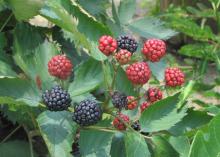Information Possibly Outdated
The information presented on this page was originally released on February 18, 2019. It may not be outdated, but please search our site for more current information. If you plan to quote or reference this information in a publication, please check with the Extension specialist or author before proceeding.
Choose excellent Sweetie Pie blackberry for Mississippi
This week, I want to spend our time considering the last of the 2019 Mississippi Medallion selections, Sweetie Pie blackberry.
When I first moved to the South in the late 1970s, we lived in a rural area of upstate South Carolina. I remember how one of my favorite things to do in the summer was pick the wild blackberries that seemed to grow everywhere.
You see, I grew up agriculture-deficient in the suburbs of Detroit, and picking wild blackberries was just not an option there. Besides enjoying the fresh-picked fruit, I also learned more than I wanted to about thorns, poison ivy, ticks, chiggers and the occasional snake that would scare the heebie-jeebies out of me.
So, I’ve come to appreciate homeowners who want to grow this delicious fruit -- especially the thornless selections -- in the relative safety and convenience of their own gardens.
Sweetie Pie blackberry was bred by the USDA in Poplarville, Mississippi, so it tolerates heat very well. This thornless plant has a vigorous growth habit, which is reflected in its copious production of large, very sweet fruit.
Sweetie Pie is an excellent choice for homeowners who wish to grow their own fruit and for you-pick operations and farmer’s markets. Like most blackberry plants, Sweetie Pie has a perennial root system but biennial canes, meaning they fruit only on the second year’s growth. Peak fruit production starts to occur in year three.
Sweetie Pie has its ripening season in the middle of or late in the blackberry-growing period, which for most of Mississippi is mid- to late June.
In addition to its excellent fruit quality, Sweetie Pie is resistant to double blossom. Also called rosette, this is a condition caused by fungus that is problematic of some blackberry cultivars.
Blackberries are among the easier fruiting plants to grow. Here are some tips for success with all blackberry selections grown in Mississippi. Remember, good management reduces overall plant stress and keeps the plants productive.
Set blackberry plants in the ground 3 to 5 feet apart in an area that receives full sunlight. February and March are good planting times, so if you’ve ever wanted a blackberry, plant one or two now.
Raised beds with consistent irrigation produce the best results. Another option is to grow them in large containers.
Blackberries are self-fertile, so there is no need to plant multiple cultivars unless desired. Bees are the primary pollinators, so encourage their activity as much as possible.
Supply fertilizer and irrigation to substantially enhance the amount and quality of fruit. Be sure to soil test at least every three years. Make sure you follow fertilization recommendations, and keep soil nutrients in the optimal ranges.
Usually, a cultivar bears fruit for 2 to 4 weeks. Blackberries need to be harvested when fully ripe, since they do not ripen after harvest. Refrigerate berries as soon as possible after harvest, and do not let harvested fruit sit in the sun. The fruit is best when consumed immediately or frozen, as it will not store fresh for long periods.
Sweetie Pie’s availability will be limited, but don’t let that stop you from growing blackberries this year. Other good thornless selections for Mississippi include Arapaho, Navaho, Ouachita and Natchez.




